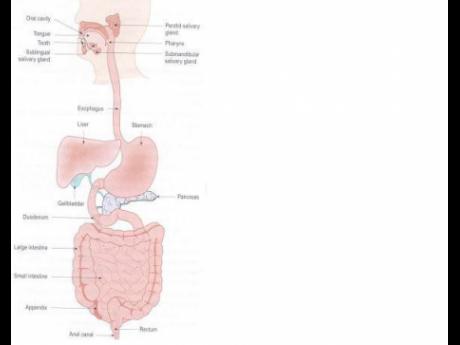Jennifer Ellison Brown: The digestive and absorptive system
The digestive and absorptive system consists of the alimentary canal (mouth, oesophagus, stomach, small intestine, large intestine, rectum and anus), salivary glands, the pancreas, the liver and the associated blood vessels.
Digestion
Digestion is the breakdown of food into simpler molecules (nutrients), which can be absorbed into the bloodstream and used by the cells of the body.
The process begins in the mouth, where the food is chewed into smaller pieces and mixes with saliva that contains the digestive enzyme amylase. Amylase digests starch (e.g. bread, rice, pasta, yam, etc.).
After chewing, the food is swallowed into the oesophagus, which leads to the stomach. Food moves through the oesophagus by a process called peristalsis, whereby muscles automatically contract, producing rhythmic waves.
When food reaches the stomach, it is mixed with a number of acidic substances, collectively called gastric juices. This gastric juice kills any harmful bacteria that may have been ingested with the food.
Some nutrients and water contained in the food are absorbed into the bloodstream. The enzyme pepsin starts the breakdown of protein. Food stays in the stomach for about two and a half hours, where it is churned into a liquefied state to form chyme.
The chyme is released in small amounts into the first part of the small intestine, the duodenum. In the duodenum, a number of enzymes produced by the gall bladder, the liver and the pancreas are mixed with the food. The gall bladder stores bile, which neutralises the acid leaving the stomach.
Bile also helps to break down fats in the small intestine. The liver produces bile, which also helps with the breakdown of carbohydrates and protein. It also acts as a filter, maintaining the balance of nutrients in the blood. The pancreas produces insulin and other enzymes, which help with the digestion of carbohydrates, fats and proteins.
The end products of digestion (glucose, amino acids and fatty acids), along with minerals, vitamins and water are absorbed into the blood stream by hair-like projections (villi) on the inner surface.
All the nutrients absorbed from the small intestine is carried to the liver first. The level of nutrients in the blood is adjusted to the best levels for the body to function. Excess glucose is converted to glycogen and fat. Glycogen is stored in the liver and muscles and fat is stored all over the body, but particularly beneath the skin. Excess fatty acid is also converted to fat, while excess amino acid is converted to glucose and the toxic waste urea. Urea is eventually excreted by the kidney.
If glucose and fatty acids are in short supply, the liver reverses the processes described above and releases glucose from the glycogen stores and fatty acids from the fat stores. The body cannot store protein. Therefore, if amino acids are in short supply, the liver cannot produce more.
After the liver has adjusted the amount of nutrients to the correct level in the blood, they pass on around the body. Glucose and fatty acids are used as energy sources. Amino acids are used to make the proteins necessary for growth and the repair of tissues; e.g. muscle tissue or as a source of energy, if necessary.
The remaining undigested food passes into the large intestine (colon), where water is reabsorbed and the undigested food moves to the rectum and eventually passed out the anus as faeces.
Digestion and exercise
Digestion and absorption requires a large volume of blood in the capillaries in the walls of the intestine. If exercise is done too soon after eating, blood is moved from the digestive process to working muscles and the food is left undigested.
It is important to keep physical activity to a minimum after eating. Generally, it is best to avoid exercising until at least three hours after a meal. By that time, the food would have entered the small intestine, where it passes quickly into the bloodstream and is stored around the body, ready to be converted to energy during physical activity.

